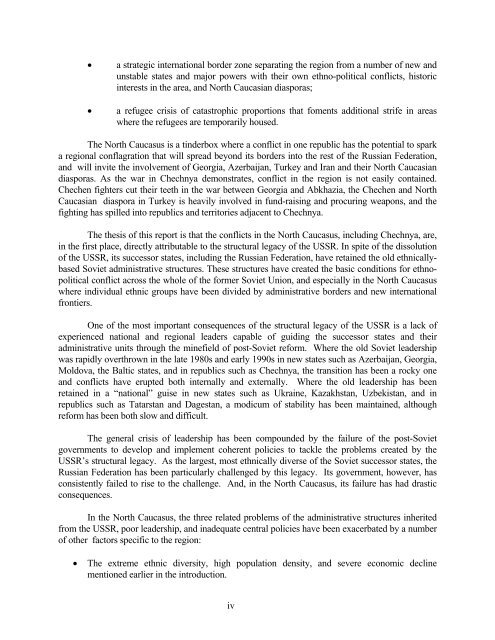RUSSIA'S TINDERBOX - Belfer Center for Science and International ...
RUSSIA'S TINDERBOX - Belfer Center for Science and International ...
RUSSIA'S TINDERBOX - Belfer Center for Science and International ...
Create successful ePaper yourself
Turn your PDF publications into a flip-book with our unique Google optimized e-Paper software.
• a strategic international border zone separating the region from a number of new <strong>and</strong><br />
unstable states <strong>and</strong> major powers with their own ethno-political conflicts, historic<br />
interests in the area, <strong>and</strong> North Caucasian diasporas;<br />
• a refugee crisis of catastrophic proportions that foments additional strife in areas<br />
where the refugees are temporarily housed.<br />
The North Caucasus is a tinderbox where a conflict in one republic has the potential to spark<br />
a regional conflagration that will spread beyond its borders into the rest of the Russian Federation,<br />
<strong>and</strong> will invite the involvement of Georgia, Azerbaijan, Turkey <strong>and</strong> Iran <strong>and</strong> their North Caucasian<br />
diasporas. As the war in Chechnya demonstrates, conflict in the region is not easily contained.<br />
Chechen fighters cut their teeth in the war between Georgia <strong>and</strong> Abkhazia, the Chechen <strong>and</strong> North<br />
Caucasian diaspora in Turkey is heavily involved in fund-raising <strong>and</strong> procuring weapons, <strong>and</strong> the<br />
fighting has spilled into republics <strong>and</strong> territories adjacent to Chechnya.<br />
The thesis of this report is that the conflicts in the North Caucasus, including Chechnya, are,<br />
in the first place, directly attributable to the structural legacy of the USSR. In spite of the dissolution<br />
of the USSR, its successor states, including the Russian Federation, have retained the old ethnicallybased<br />
Soviet administrative structures. These structures have created the basic conditions <strong>for</strong> ethnopolitical<br />
conflict across the whole of the <strong>for</strong>mer Soviet Union, <strong>and</strong> especially in the North Caucasus<br />
where individual ethnic groups have been divided by administrative borders <strong>and</strong> new international<br />
frontiers.<br />
One of the most important consequences of the structural legacy of the USSR is a lack of<br />
experienced national <strong>and</strong> regional leaders capable of guiding the successor states <strong>and</strong> their<br />
administrative units through the minefield of post-Soviet re<strong>for</strong>m. Where the old Soviet leadership<br />
was rapidly overthrown in the late 1980s <strong>and</strong> early 1990s in new states such as Azerbaijan, Georgia,<br />
Moldova, the Baltic states, <strong>and</strong> in republics such as Chechnya, the transition has been a rocky one<br />
<strong>and</strong> conflicts have erupted both internally <strong>and</strong> externally. Where the old leadership has been<br />
retained in a “national” guise in new states such as Ukraine, Kazakhstan, Uzbekistan, <strong>and</strong> in<br />
republics such as Tatarstan <strong>and</strong> Dagestan, a modicum of stability has been maintained, although<br />
re<strong>for</strong>m has been both slow <strong>and</strong> difficult.<br />
The general crisis of leadership has been compounded by the failure of the post-Soviet<br />
governments to develop <strong>and</strong> implement coherent policies to tackle the problems created by the<br />
USSR’s structural legacy. As the largest, most ethnically diverse of the Soviet successor states, the<br />
Russian Federation has been particularly challenged by this legacy. Its government, however, has<br />
consistently failed to rise to the challenge. And, in the North Caucasus, its failure has had drastic<br />
consequences.<br />
In the North Caucasus, the three related problems of the administrative structures inherited<br />
from the USSR, poor leadership, <strong>and</strong> inadequate central policies have been exacerbated by a number<br />
of other factors specific to the region:<br />
• The extreme ethnic diversity, high population density, <strong>and</strong> severe economic decline<br />
mentioned earlier in the introduction.<br />
iv
















